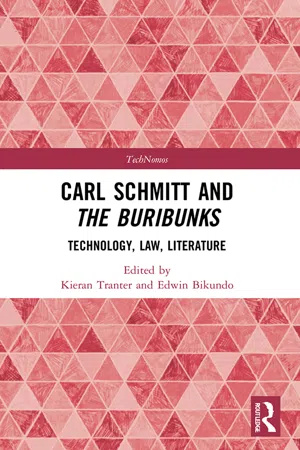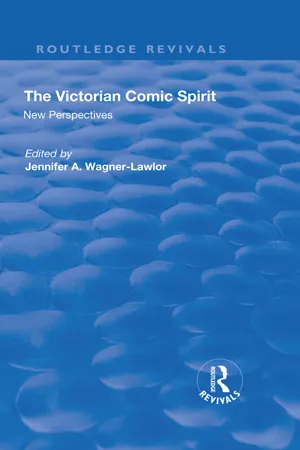Literature
Pastiche
Pastiche is a literary technique that involves imitating or borrowing elements from other works of literature, often for the purpose of paying homage or creating a sense of nostalgia. It can involve the use of specific styles, themes, or characters from other works, and is often used to create a sense of familiarity or to evoke a particular mood or tone.
Written by Perlego with AI-assistance
Related key terms
1 of 4
Related key terms
1 of 3
3 Key excerpts on "Pastiche"
- eBook - ePub
Carl Schmitt and The Buribunks
Technology, Law, Literature
- Edwin Bikundo, Kieran Tranter, Edwin Bikundo, Kieran Tranter(Authors)
- 2022(Publication Date)
- Routledge(Publisher)
The Buribunks ’s publication, is that of Pastiche. Pastiche is often confused with parody or imitation, or even forgery. However, Pastiche is dissimilar to these three in that it is neither a literary genre nor a usurpation. It is a technique that can be subsumed under multiple literary forms. Before continuing, as we address primarily an English-speaking audience, it is essential to precisely define Pastiche as a literary technique given that a major debate, from which we will depart, has profoundly shaped (especially) the English understanding of this word.The short long story of the Pastiche as ‘criticism in action’
As a matter of fact, major works on postmodernism and its intricate relation with, and deep rooting in, modernity and modernism understand Pastiche as a genre opposed to parody. Indeed, ‘as a formal game, Pastiche in contemporary literature is often associated with postmodernism in its English-speaking meaning of gratuitous game or blank parody’.13 According to Frederic Jameson, Pastiche ‘is to be sharply distinguished from the more readily received idea of parody’.14 He explains:Pastiche is, like parody, the imitation of a peculiar or unique, idiosyncratic style, the wearing of a linguistic mask, speech in a dead language. But it is a neutral practice of such mimicry, without any of parody’s ulterior motives, amputated of the satiric impulse, devoid of laughter and of any conviction that alongside the abnormal tongue you have momentarily borrowed, some healthy linguistic normality still exists. Pastiche is thus blank parody, a statue with blind eyeballs.15In this sense, he asserts a ‘formal’ resemblance between parody and Pastiche while emphasising their profound difference (motivated/political vs. neutral/apolitical). He then concludes that Pastiche is disconnected from history. It is not a historical thing, but only a ‘random cannibalization of all the styles of the past, [a] play of random stylistic allusion’,16 ‘freed from [any] historical forces … Pastiche means style separated from history.’17 - eBook - ePub
The Victorian Comic Spirit
New Perspectives
- Jennifer Wagner-Lawlor(Author)
- 2017(Publication Date)
- Routledge(Publisher)
lolanthe). This humorously mixed form of the Savoy operas demanded a certain kind of appreciation for its effects to be recognized: an urbane, sophisticated (and perhaps somewhat self-satisfied) sense of knowingness on the part of the audience—or, at least, an upwardly-mobile aspiration toward such a sense of cultural facility—was part of the charm, part of the light but distinctly intellectual pleasure afforded by Gilbert and Sullivan.Let us begin with Pastiche and move toward parody. I should stress that I mean to use “Pastiche” as a term of praise. Fredric Jameson’s notion of Pastiche as “blank” and neutralized is an overly-restricted notion of the practice.1 One aesthetic sense of the term “Pastiche” derives from the Italian, pasticcio, a pie or pasty containing a number of various ingredients, and this Italian sense was still active in the nineteenth-century theatrical context as a name for certain forms of mixed parody, burlesque, and musical entertainment. This hodgepodge variety, this rampant eclecticism should be as important to our historical sense of Pastiche as is the more dominant sense of the term, which indicates an extensive, pervasive, or diffuse imitation of one stylistic model. The Savoy operas take advantage of Pastiche in both these senses, revelling as they do both in general parodies of style and in recombinant mixtures of disparate generic take-offs, juxtaposed and jostling against one another.As Margaret Rose points out (with reference to the eclecticism of both nineteenth-century and postmodern architecture), “a compilation of different styles [may] deliberately [be] used to constitute a new historicist style” (74). This practice of eclectic citation is not necessarily (or, at least it is not only) nostalgic; for just as much as it may cherish old forms of social and theatrical life, representing them in a bid for fond recognition, it can also show them to be outmoded and ridiculous. As is the case with the related notion of parody, Pastiche can equally imply critique and homage, dismantling and reconstruction. Both aesthetic modes, however, have the historicizing effect of seeming to cast the objects of their representation into the past, even while momentarily reviving them. Because parody makes its object a part of its own structure, it preserves, transmits, and makes its object traditional, while at the same time it provides a. frisson - Matthias Stephan(Author)
- 2019(Publication Date)
- Palgrave Macmillan(Publisher)
itself.While in much of her argumentation, Hutcheon asserts a use of parody which concurs with Abrams’ definition, she also asserts, in establishing parody’s validity to the discussion, that “parody – often called ironic quotation, Pastiche , appropriation, or intertextuality – is usually considered central to postmodernism , both by its detractors and its defenders ” (Hutcheon 1989 , 93), which conflates the idea of parody with less hierarchical terms like appropriation and intertextuality , as well as the notion of quotation, which removes the ridicule element, and the sense of Pastiche . Fredric Jameson argues, essentially, that postmodern parody isn’t the correct term, as parody has distinct motivations, which postmodernism does not share.In this situation parody finds itself without a vocation; it has lived, and that strange new thing Pastiche slowly comes to take its place. Pastiche is, like parody, the imitation of a peculiar or unique, idiosyncratic style, the wearing of a linguistic mask, speech in a dead language. But it is a neutral practice of such mimicry, without any of parody’s ulterior motives, amputated of the satiric impulse, devoid of laughter and of any conviction that alongside the abnormal tongue you have momentarily borrowed, some healthy linguistic normality still exists. Pastiche is thus blank parody, a statue with blind eyeballs: it is to parody what that other interesting and historically original modern thing, the practice of a kind of blank irony , is to what Wayne Booth calls the ‘stable ironies’ of the eighteenth century . (Jameson 1991 , 17)Arguably, while parody retains the dual hierarchical notion of the original and its follower—regardless whether one considers the parody as extracting value from a dead genre or as an inferior mocking copy of a reinforced potent predecessor—Pastiche has no such pretense. While Hutcheon critiques Jameson’s position as one of disavowal of contemporary possibilities of uniqueness, I would argue that Pastiche presents a postmodern variety of citation which need not reinforce or sit in supplication of an original, but simply provides an interweaving of the already conceived. This aligns with Kristeva’s notion of intertextuality , which recognizes the openness of any work. “The theory of intertextuality insists that a text … cannot exist as a hermetic system or self-sufficient whole. … Firstly, the writer is a reader of texts … before s/he is a creator of texts, and therefore the work of art is inevitably shot through with references, quotations and influences of every kind” (Still and Worton 1990 , 1). Keeping in mind notions like Barthes’ “Death of the Author” and the constant invocation of new and intricate connections that readers/consumers continue to make, intertextuality and by proxy Pastiche seem to reflect the postmodern structure of consciousness more than the notion of parody. Unlike parody, Pastiche
Index pages curate the most relevant extracts from our library of academic textbooks. They’ve been created using an in-house natural language model (NLM), each adding context and meaning to key research topics.
Explore more topic indexes
Explore more topic indexes
1 of 6
Explore more topic indexes
1 of 4


